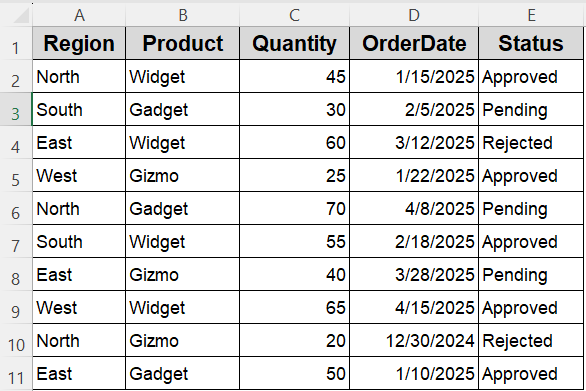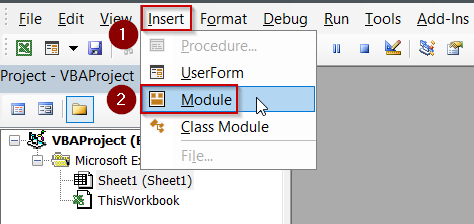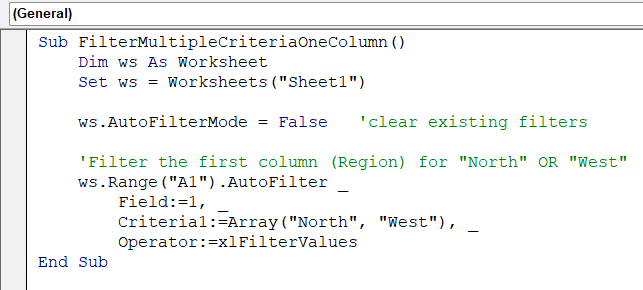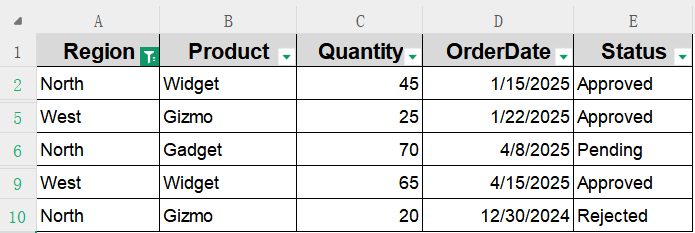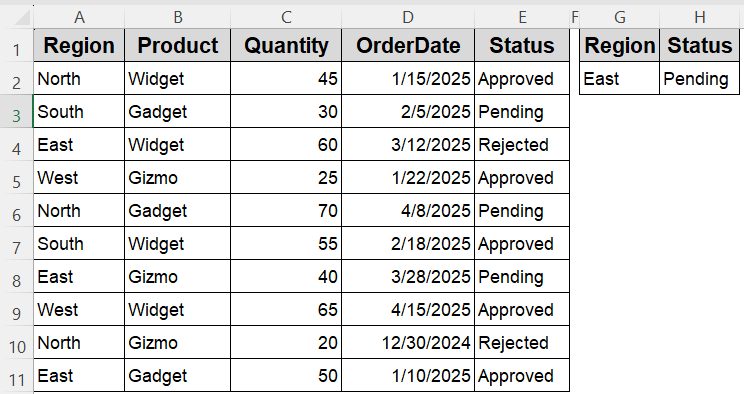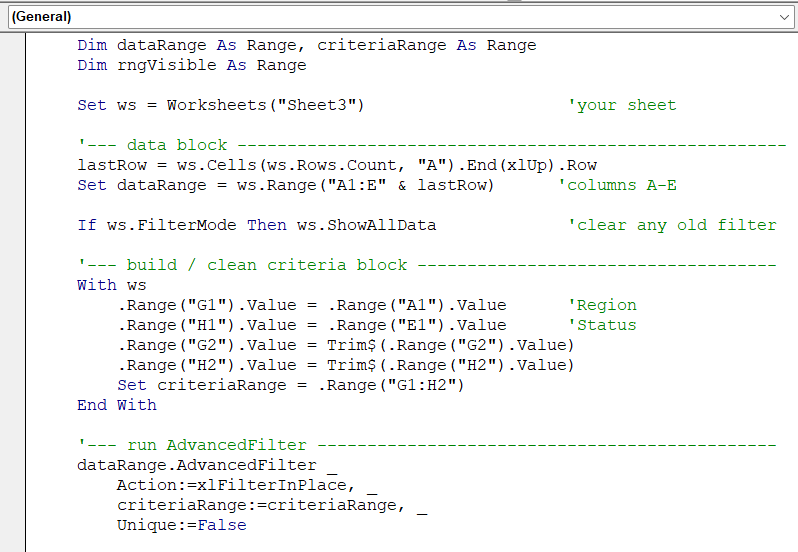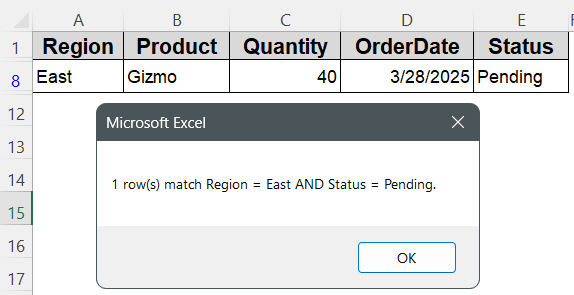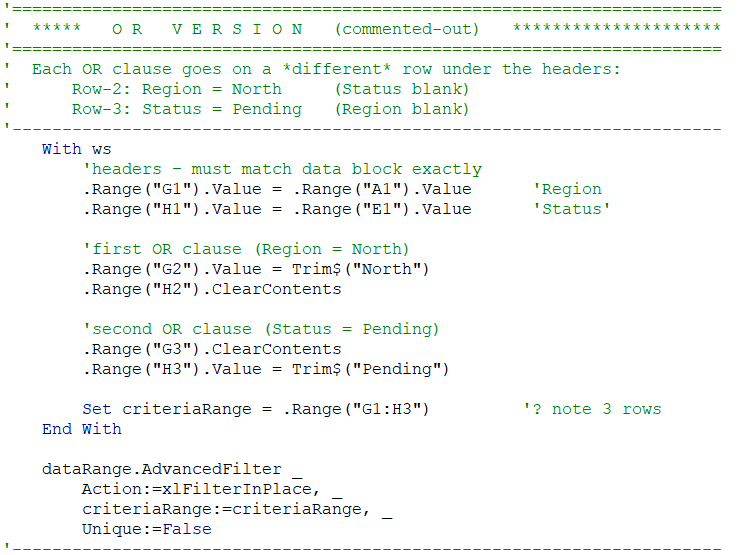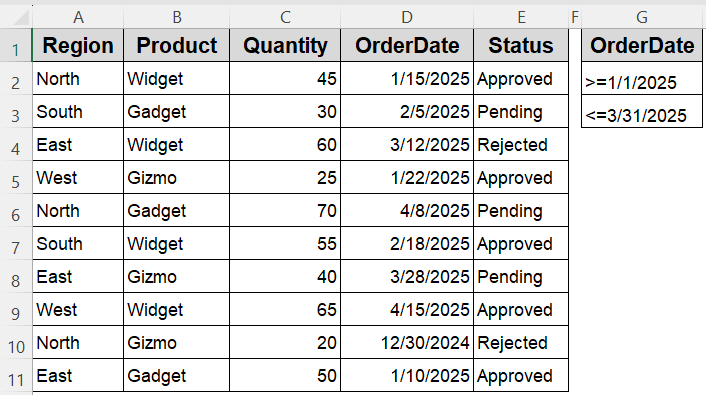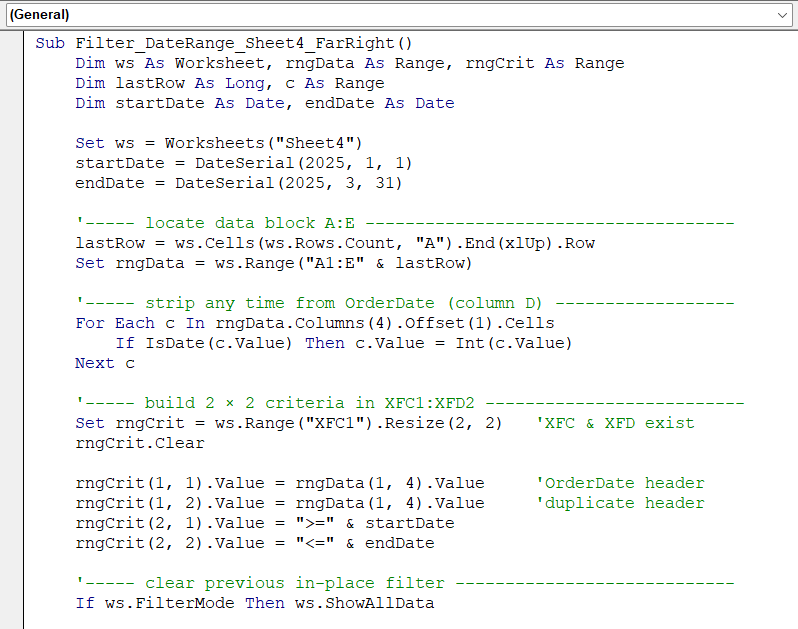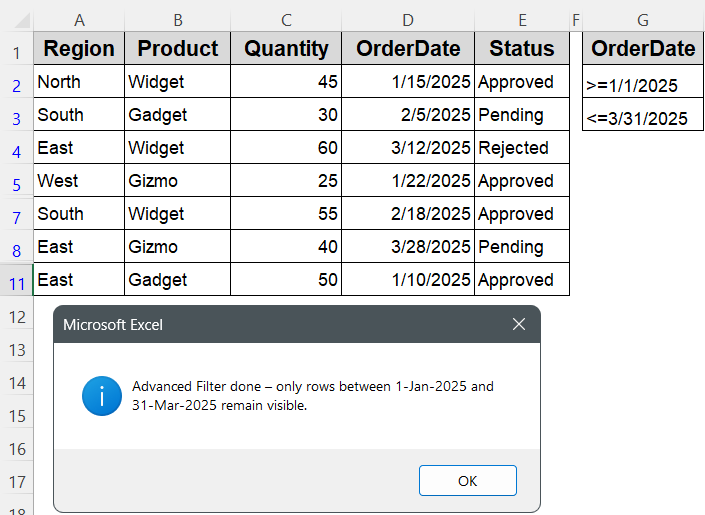Filtering data in Excel is easy when you do it by hand, but it can take a lot of time if the table is big or the filters are complicated. With VBA, you can apply many filter conditions at once, hide rows that don’t match, and even copy the results to another sheet, all with one click and no manual work..
In this article, we’ll explore four practical ways to apply an Excel VBA filter with multiple criteria. You’ll learn how to use AutoFilter for several values in one column, combine AutoFilter across different columns, build AdvancedFilter rules for AND and OR logic, and create range-based filters for dates or numbers.
Steps to filter data using AdvancedFilter with AND and OR criteria in Excel VBA:
➤ Open the VBA Editor (press Alt + F11).
➤ Insert a new module and paste the following code:
Sub AdvancedFilter_AND_OR()
Dim ws As Worksheet
Dim lastRow As Long
Dim dataRange As Range, criteriaRange As Range
Dim rngVisible As Range
Set ws = Worksheets("Sheet4") ' Change to your sheet name
' Define the data range (columns A to E)
lastRow = ws.Cells(ws.Rows.Count, "A").End(xlUp).Row
Set dataRange = ws.Range("A1:E" & lastRow)
' Clear any existing filters
If ws.FilterMode Then ws.ShowAllData
' ----- AND logic (criteria side-by-side on same row) -----
With ws
.Range("G1").Value = .Range("A1").Value ' Region header
.Range("H1").Value = .Range("E1").Value ' Status header
.Range("G2").Value = "East" ' Region criteria
.Range("H2").Value = "Pending" ' Status criteria
Set criteriaRange = .Range("G1:H2")
End With
dataRange.AdvancedFilter _
Action:=xlFilterInPlace, _
CriteriaRange:=criteriaRange, _
Unique:=False
' ----- Uncomment below to test OR logic (criteria stacked in rows) -----
' With ws
' .Range("G1").Value = .Range("A1").Value ' Region header
' .Range("H1").Value = .Range("E1").Value ' Status header
'
' .Range("G2").Value = "East" ' First OR criteria: Region=East
' .Range("H2").ClearContents
'
' .Range("G3").ClearContents
' .Range("H3").Value = "Pending" ' Second OR criteria: Status=Pending
'
' Set criteriaRange = .Range("G1:H3")
' End With
'
' dataRange.AdvancedFilter _
' Action:=xlFilterInPlace, _
' CriteriaRange:=criteriaRange, _
' Unique:=False
' Count visible rows after filter
On Error Resume Next
Set rngVisible = dataRange.Columns(1).SpecialCells(xlCellTypeVisible)
On Error GoTo 0
If rngVisible Is Nothing Then
MsgBox "No rows meet the criteria."
Else
MsgBox rngVisible.Count - 1 & " row(s) remain visible."
End If
End Sub➤ Close the VBA Editor and run the macro (press F5).
➤ The data will be filtered in place, showing rows matching the AND criteria.
➤ To test OR logic, uncomment the OR block inside the code and comment out the AND block.
Use AutoFilter with Multiple Criteria in One Column
Filtering data in Excel manually is fine for small sets, but when you have many rows and want to filter by several values in the same column, VBA AutoFilter helps automate this. You can filter a single column by multiple criteria simultaneously, such as filtering for Region “North” or “West” at once.
For this demo, we’ll use the dataset on a sheet named Data with columns Region, Product, Quantity, OrderDate, and Status. The macro applies AutoFilter to the Region column using two criteria at the same time.
The filtered table will show only rows where the Region is either “North” or “West.” This method is fast and straightforward when your filtering is limited to multiple values within one column.
Steps:
➤ Create a copy of your original dataset to use this method. You will apply the method to the copied dataset.
➤ Press Alt + F11 to open the VBA Editor.
➤ Insert a new module: go to Insert >> Module.
➤ Copy and paste the following code:
Sub FilterMultipleCriteriaOneColumn()
Dim ws As Worksheet
Set ws = Worksheets("Sheet1")
ws.AutoFilterMode = False 'clear existing filters
'Filter the first column (Region) for "North" OR "West"
ws.Range("A1").AutoFilter _
Field:=1, _
Criteria1:=Array("North", "West"), _
Operator:=xlFilterValues
End Sub
➧ ws.Range("A1").AutoFilter applies AutoFilter starting from the header cell A1.
➧ Field:=1 specifies the first column, which is “Region” in this dataset. Change this if your column order is different.
➧ Criteria1:=Array("North", "West") tells AutoFilter to filter for both values in the array using an OR logic.
➧ Operator:=xlFilterValues allows filtering by multiple values in one column using an array.
➤ Close the VBA Editor and return to Excel.
➤ Press Alt + F8 , select FilterMultipleCriteriaOneColumn, and click Run. Make sure you are applying this method to the copied dataset and not the original one.
The sheet will now show only rows where the Region is “North” or “West.”. It will hide the columns that do not match the criteria.
➤ You can customize the array with any values you want to filter by in that column.
Apply AutoFilter with Multiple Criteria Across Multiple Columns
Filtering on multiple columns with different criteria is common when you want to narrow down data precisely. With VBA AutoFilter, you can specify conditions for each column individually, such as showing only rows where Region is “North” or “West” and Status is “Pending” or “Shipped.”
The macro will filter Region to “North” or “West” while filtering Status to “Pending” or “Shipped” simultaneously. After running the macro, only rows meeting both conditions will remain visible. This method combines multiple filters to work together with AND logic between columns and OR logic within each column’s criteria.
Steps:
➤ Open the VBA Editor with Alt + F11 .
➤ Insert a new module via Insert >> Module.
➤ Paste the following code:
Sub FilterMultipleCriteriaMultipleColumns()
Dim ws As Worksheet
Set ws = Worksheets("Data")
ws.AutoFilterMode = False 'Clear existing filters
With ws.Range("A1").CurrentRegion
'Filter Region (Field 1) for North or West
.AutoFilter Field:=1, Criteria1:=Array("North", "West"), Operator:=xlFilterValues
'Filter Status (Field 5) for Pending or Shipped
.AutoFilter Field:=5, Criteria1:=Array("Pending", "Shipped"), Operator:=xlFilterValues
End With
End Sub➧ With ws.Range("A1").CurrentRegion targets the whole data block starting from A1.
➧ Field:=1 applies the filter on the first column (Region), with multiple criteria using an array.
➧ Field:=5 applies a separate filter on the fifth column (Status), again with multiple criteria.
➧ Operator xlFilterValues is used to specify multiple filter values per column.
➤ This method is ideal when filtering on multiple columns with complex criteria per column.
➤ Close the editor, return to Excel.
➤ Run the macro via Alt + F8 , select FilterMultipleCriteriaMultipleColumns, and click Run.
Only rows with Region as “North” or “West” and Status as “Pending” or “Shipped” will be shown.
Explore AdvancedFilter with AND and OR Criteria
Excel’s AdvancedFilter lets you filter data based on more complex conditions than AutoFilter, including logical AND and OR combinations. Unlike AutoFilter, AdvancedFilter uses a criteria range where you set up rules on one or multiple columns.
For this demonstration, we’ll use the Data sheet and create a criteria range that filters rows where the Region is “East” AND the Status is “Pending.” Then, we’ll modify it to filter rows where Region is “East” OR Status is “Pending.”
This method shows how to set up criteria ranges properly for AND vs OR logic and run the AdvancedFilter to extract matching rows to place elsewhere or filter in place.
Steps:
➤ On the Data sheet, pick two empty columns well to the right of your table (for example, G and H).
➤ In G1 type Region. In H1 type Status, these must match the table headers exactly.
➤ In G2 type East. In H2 type Pending.
➤ Open the VBA Editor with Alt + F11 .
➤ Insert a new module via Insert >> Module.
➤ Add the following VBA code:
Sub AdvancedFilter_AND() '‑‑‑‑ change to _OR if you like
Dim ws As Worksheet
Dim lastRow As Long
Dim dataRange As Range, criteriaRange As Range
Dim rngVisible As Range
Set ws = Worksheets("Sheet3") 'your sheet
'--- data block -------------------------------------------------------
lastRow = ws.Cells(ws.Rows.Count, "A").End(xlUp).Row
Set dataRange = ws.Range("A1:E" & lastRow) 'columns A‑E
If ws.FilterMode Then ws.ShowAllData 'clear any old filter
'======================================================================
' ***** A N D V E R S I O N (active) **************************
'======================================================================
' Criteria are placed on the *same* row ⇒ all must be TRUE
'----------------------------------------------------------------------
With ws
'headers – must match data block exactly
.Range("G1").Value = .Range("A1").Value 'Region
.Range("H1").Value = .Range("E1").Value 'Status
'criteria values
.Range("G2").Value = Trim$("North")
.Range("H2").Value = Trim$("Pending")
Set criteriaRange = .Range("G1:H2") 'one criteria row
End With
dataRange.AdvancedFilter _
Action:=xlFilterInPlace, _
CriteriaRange:=criteriaRange, _
Unique:=False
'----------------------------------------------------------------------
'=======================================================================
' ***** O R V E R S I O N (commented‑out) *********************
'=======================================================================
' Each OR clause goes on a *different* row under the headers:
' Row‑2: Region = North (Status blank)
' Row‑3: Status = Pending (Region blank)
'-----------------------------------------------------------------------
' With ws
' 'headers – must match data block exactly
' .Range("G1").Value = .Range("A1").Value 'Region
' .Range("H1").Value = .Range("E1").Value 'Status'
'
' 'first OR clause (Region = North)
' .Range("G2").Value = Trim$("North")
' .Range("H2").ClearContents
'
' 'second OR clause (Status = Pending)
' .Range("G3").ClearContents
' .Range("H3").Value = Trim$("Pending")
'
' Set criteriaRange = .Range("G1:H3") '← note 3 rows
' End With
'
' dataRange.AdvancedFilter _
' Action:=xlFilterInPlace, _
' CriteriaRange:=criteriaRange, _
' Unique:=False
'-----------------------------------------------------------------------
'--- how many rows are visible? ---------------------------------------
On Error Resume Next
Set rngVisible = dataRange.Columns(1).SpecialCells(xlCellTypeVisible)
On Error GoTo 0
If rngVisible Is Nothing Then
MsgBox "No rows meet the criteria."
Else
MsgBox rngVisible.Count - 1 & _
" row(s) remain visible."
End If
End Sub
➧ The criteria range must be set up correctly: AND criteria go side-by-side on the same row; OR criteria go down a single column.
➧ Action:=xlFilterInPlace filters the original data without copying it elsewhere. Change to xlFilterCopy with CopyToRange to output filtered results separately.
➧ The macro clears existing filters before running.
➤ On your Data sheet, set up the criteria range as explained in the comments (cells G1:H2 for AND criteria).
➤ Run the macro, and it will filter the data in place using AND logic.
Uncomment the OR section in the code and adjust the criteria range if you want to try OR logic.
The code should now filter using the OR logic
➤ This method is powerful for complex filtering needs beyond AutoFilter’s capabilities.
Filter Data Within an Interval Using AdvancedFilter
Filtering rows that fall within a specific period is a common task. With VBA you can use AdvancedFilter to keep only the records whose OrderDate is between two dates you choose.
For this demo, we will work with the same Data sheet that holds Region, Product, Quantity, OrderDate, and Status. Our goal is to show only rows dated 01‑Jan‑2025 to 31‑Mar‑2025. After you run the macro, the table shrinks to the matching dates. You can filter in place or copy the results elsewhere for a clean report.
Steps:
➤ Add a blank separator column F (leave the whole column empty).
➤ In G1 type OrderDate (match the header in E1 exactly).
➤ In G2 type =”>=” & DATE(2025,1,1).
➤ In G3 type =”<=” & DATE(2025,3,31).
➤ Press Alt + F11 to open the VBA Editor.
➤ Go to Insert >> Module to add a new module.
➤ Paste the code below:
Sub Filter_DateRange_Sheet4_FarRight()
Dim ws As Worksheet, rngData As Range, rngCrit As Range
Dim lastRow As Long, c As Range
Dim startDate As Date, endDate As Date
Set ws = Worksheets("Sheet4")
startDate = DateSerial(2025, 1, 1)
endDate = DateSerial(2025, 3, 31)
'----- locate data block A:E -------------------------------------
lastRow = ws.Cells(ws.Rows.Count, "A").End(xlUp).Row
Set rngData = ws.Range("A1:E" & lastRow)
'----- strip any time from OrderDate (column D) ------------------
For Each c In rngData.Columns(4).Offset(1).Cells
If IsDate(c.Value) Then c.Value = Int(c.Value)
Next c
'----- build 2 × 2 criteria in XFC1:XFD2 --------------------------
Set rngCrit = ws.Range("XFC1").Resize(2, 2) 'XFC & XFD exist
rngCrit.Clear
rngCrit(1, 1).Value = rngData(1, 4).Value 'OrderDate header
rngCrit(1, 2).Value = rngData(1, 4).Value 'duplicate header
rngCrit(2, 1).Value = ">=" & startDate
rngCrit(2, 2).Value = "<=" & endDate
'----- clear previous in‑place filter ----------------------------
If ws.FilterMode Then ws.ShowAllData
'----- apply Advanced Filter -------------------------------------
rngData.AdvancedFilter _
Action:=xlFilterInPlace, _
CriteriaRange:=rngCrit, _
Unique:=False
MsgBox "Advanced Filter done – only rows " & _
"between " & Format(startDate, "d‑mmm‑yyyy") & _
" and " & Format(endDate, "d‑mmm‑yyyy") & _
" remain visible.", vbInformation
End Sub
➧ AdvancedFilter checks those conditions row by row and hides dates outside the range.
➧ If ws.FilterMode Then ws.ShowAllData safely removes any existing filter before applying the new one.
➧ Change OrderDate to another column header or adjust the two dates to fit any interval you need.
➤ Run the macro with Alt + F8 , choose AdvancedFilter_DateInterval, and click Run. Only rows within the chosen date range stay visible.
Use this approach whenever you must limit your data to a particular period without manually applying date filters.
Frequently Asked Questions
How do I filter multiple values in one column using VBA?
Use AutoFilter with an array: Field:=1, Criteria1:=Array(“A”, “B”), Operator:=xlFilterValues to filter multiple values in a single column.
Can I filter data across multiple columns with VBA?
Yes, apply AutoFilter on each column separately. Set the correct Field number for each and apply criteria to filter data across multiple columns simultaneously.
What’s the difference between AutoFilter and AdvancedFilter in VBA?
AutoFilter is easier for simple filters. AdvancedFilter supports complex logic (AND/OR) and allows copying filtered results to another location or applying range-based criteria.
How do I filter by date or number ranges using VBA?
Use AdvancedFilter with criteria like “>=1/1/2024” and “<=12/31/2024” in separate columns to apply numeric or date range filters accurately.
Wrapping Up
Using Excel VBA to filter multiple criteria makes working with data faster and easier. You can quickly show only the information you need by using AutoFilter or AdvancedFilter. These tools help you filter by many values, across columns, or by date and number ranges. Learning these methods saves time and helps you work more efficiently. Try them out to make your Excel tasks simpler and quicker!


